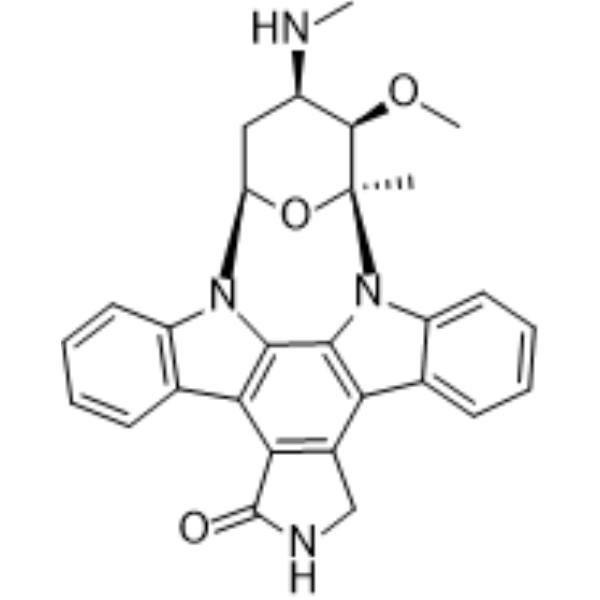Home
Products
Staurosporine



| Product Name | Staurosporine |
| Price: | Inquiry |
| Catalog No.: | CN00383 |
| CAS No.: | 62996-74-1 |
| Molecular Formula: | C28H26N4O3 |
| Molecular Weight: | 466.53 g/mol |
| Purity: | >=98% |
| Type of Compound: | Alkaloids |
| Physical Desc.: | Powder |
| Source: | |
| Solvent: | Chloroform, Dichloromethane, Ethyl Acetate, DMSO, Acetone, etc. |
| SMILES: | CN[C@H]1C[C@@H]2O[C@]([C@H]1OC)(C)n1c3ccccc3c3c1c1n2c2ccccc2c1c1c3CNC1=O |
| Contact us | |
|---|---|
| First Name: | |
| Last Name: | |
| E-mail: | |
| Question: | |
| Description | Staurosporine is a potent and non-selective inhibitor of protein kinases with IC50s of 6 nM, 15 nM, 2 nM, and 3 nM for PKC, PKA, c-Fgr, and Phosphorylase kinase respectively. |
| Target | PKC:6 nM (IC50) c-Fgr:2 nM (IC50) Phosphorylase kinase:3 nM (IC50) v-Src:6 nM (IC50) cdc2:9 nM (IC50) TPK-IIB/Syk:16 nM (IC50) Ca2+/CaM PK-I1:20 nM (IC50) MLCK:21 nM (IC50) IR:61 nM (IC50) EGF-R:100 nM (IC50) ERK-1:1500 nM (IC50) CSK:2000 nM (IC50) IGF-IR:6150 nM (IC50) CK2:19500 nM (IC50) CK1:163500 nM (IC50) S6 kinase (70 kDa):5 nM (IC50) PKA:15 nM (IC50) |
| In Vitro | Staurosporine, widely used as a protein kinase C (PKC) inhibitor with a broad spectrum of activity, is an alkaloid isolated from the culture broth of Streptomyces staurospores. MC3T3E-1 osteoblasts, expose to Staurosporine (100 nM) for 12 h, release an amount of LDH (12.4±3.1%) that is similar to that release by the control cells(10.0±2.4%), indicating the relative absence of lytic death, which occurs in necrosis. In addition, treatment with Staurosporine (100 nM) results in morphological changes, characteristic of apoptosis: a brightblue fluorescent condensed nuclei seen through a fluorescence microscope after Hoechst 33258-staining, and a reduction of cell volume[2]. |
| In Vivo | The inhibitory effect of Staurosporine is statistically significant at around Wk 10 of tumor promotion. Although statistically significant inhibition is not obtained with 10 ng of Staurosporine in later weeks of the experiment, a decreasing tendency in the percentages of tumor bearing mice and in average numbers of tumors per mouse is apparent. Thus, Staurosporine slightly inhibits tumor promotion of Teleocidin, even at the dose at which Staurosporine itself induced tumors[3]. Staurosponne (0.05 and 0.1 mg/kg intraperitoneal) attenuates the impaired perlormance of water maze and passive avoidance tasks, even though the drug administration began 2 weeks after the lesion. Moreover, Staurosporine (0.1 mg/kg) partially reversed the decrease of choline acetyltransferase activity in the fronto-parietal cortex induced by basal forebrain-lesion. These results suggest that Staurosporine attenuates impairment of learning through reversal of damage to cholinergic neurons induced by basal forebrain-lesion[4]. |
| Animal Admin | Mice[3] Female CD-I mice are used. Various amounts of Staurosporine in 10 μL of acetone are applied to the ears of 8-wk-old CD-I mice. The extent of irritation is expressed as the minimum dose of the compound causing irritation. Induction of HOC in Mouse Skin Staurosporine in 0.1 mL of acetone is applied to the skin of the backs of CD-I mice, and a crude enzyme extract is obtained from the skin 18 h later. HDC activity is expressed as pmol of CO2 released per mg of protein per l h of incubation. Induction of ODC in Mouse Skin Staurosporine in 0.2 mL of acetone is applied to the skin of the backs of CD-I mice. After 4 h, a crude enzyme extract is prepared from the epidermis, and its ODC activity is measured. Enzyme activity is expressed as nmol of CO2 per mg of protein per 30 min of incubation. Rats[4] Male Kbl Wistar rats(weighing 270 to 310 g) are used. In the group which is given Staurosporine for 2 weeks, the water maze task and Staurosporine administration are started 2 weeks after the BF-lesion, and the passive avoidance task is carried out 4 weeks after the BFlesion. The rat received Staurosporine at doses of 0.01, 0.03, 0.1, and 0.3 mg/kg (i.p., N=10 in each group for 2 weeks) 30 mm prior to the water maze training sessions and the passive avoidance task acquisitiontrial. In the group which is given Staurosporine for 4 weeks, the drug is first given 2 weeks after the BF-lesion. The water maze task is carried out 4 weeks after the BF-lesion. The passive avoidance task is carried out 6 weeks after the BF-lesion. The rat received Staurosporine at 0.05, 0.1, and 0.2 mg/kg (i.p., N=10 in each group) once a day for 2 weeks before training, and for 2 weeks after the water maze training sessions and the passive avoidance task acquisition trial. Staurosporine is suspended in 0.3% of sodium carboxymethyl cellulose. The vehicle is administered to the non-lesioned controls and the lesioned controls on the same schedule as the Staurosporine-treated animals. |
| Density | 1.6±0.1 g/cm3 |
| Boiling Point | 677.5±55.0 °C at 760 mmHg |
| Flash Point | 363.6±31.5 °C |
| Exact Mass | 466.200500 |
| PSA | 69.45000 |
| LogP | 4.40 |
| Vapour Pressure | 0.0±2.1 mmHg at 25°C |